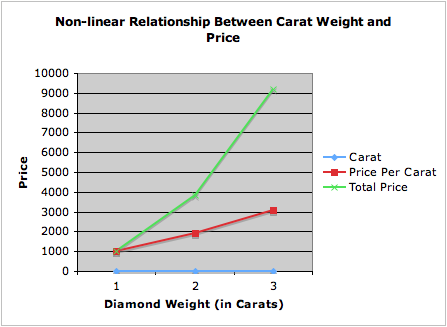


Understanding Diamond Value
A diamond's value is determined by it's characteristics, and the market demand for diamonds of that type.
Diamond Characteristics AKA "the four 'C's."
» Carat Weight
Of course it seems obvious that the more you get of something, the higher the value. But the relationship between diamond weight and value is not linear. Larger Diamonds (especially those that at the better end of the color and clarity spectrum) are considerably more rare, and therefore valuable. Below is a graph to illustrate the situation, the price is simplified for demonstration, but it reflects the actual price per carat of diamonds based on the leading diamond price guide The Rappaport Diamond Report, which is the standard for the industry.
Price and Weight
Consider several diamonds with color D (highest grade) and clarity IF (highest grade), varying by weight. If we imagine a per carat price of $1000 (purely for illustration and easy math!) we see the following price trend.
| Carat | Price per Carat | Total Price (weight * price per carat) |
|---|---|---|
| 1.0 | $1000 | $1000 |
| 2.0 | $1,909 | $3,819 |
| 3.0 | $3,055 | $9,166 |
And as we can see in the following graph, the linear increase in per carat price (multiplied by the carat weight) creates a dramatic increase in total diamond value as the size of the stone increases.
Why is this so?
This is entirely due to the rarity of the large diamonds. When a rough diamond is cut, it must be cut around a area of contiguous clarity and quality. Rough diamonds can contain many frustrating cracks and imperfections that would prevent them from being cut into a large single stone. This makes large high quality diamonds both rare and valuable.
» Cut
Cut impacts the value of a diamond because, again, of the rarity and constraints of rough diamonds. Not only must the gem region of the cut diamond be free of imperfections, it must also conform as best as possible to the ideal dimensions of height and width.
» Color and Clarity
These two variables are fairly self explanatory, the fewer imperfections (clarity) and the closer to colorless (color) the diamond is, the rarer and more desirable it is. Being a natural gem, diamonds tend to have inclusions which effects its clarity and trace minerals which it effects it's color. It often takes a trained jeweler to discern the differences between the color grades, but they are a consideration when buying any diamond.
» Market
There is one more thing that should be considered along with the four C's when sellling a diamond: the diamond market. The diamond market does fluctuate. There are many reasons, including geopolitics, global economy and demand. De Beers once attempted to control the supply of diamonds in order to establish a minimum market price for diamonds. De Beers has since ended this practice and diamonds trade more or less freely. The end of this practice lowered the value of smaller diamonds, as they are far more numerous. But, even with De Beers new relaxed policies, the market value of large diamonds remains strong.
With over 20 years combined experience in the fine jewelry business, we have the expertise you need to correctly appraise your diamond. We have access to a vast jewelry buying network and can often help you get more money for your fine diamond. If you would like answers to questions about selling a diamond follow this link: Diamond Selling. To learn more about our diamond buying services follow this link: Diamond Buying Service. If you have any additional questions or need any information not on this web site, please feel free to contact us by following this link: Contact us

Call us toll-free:
1(888)627-1137
- or -
Email Us Direct

